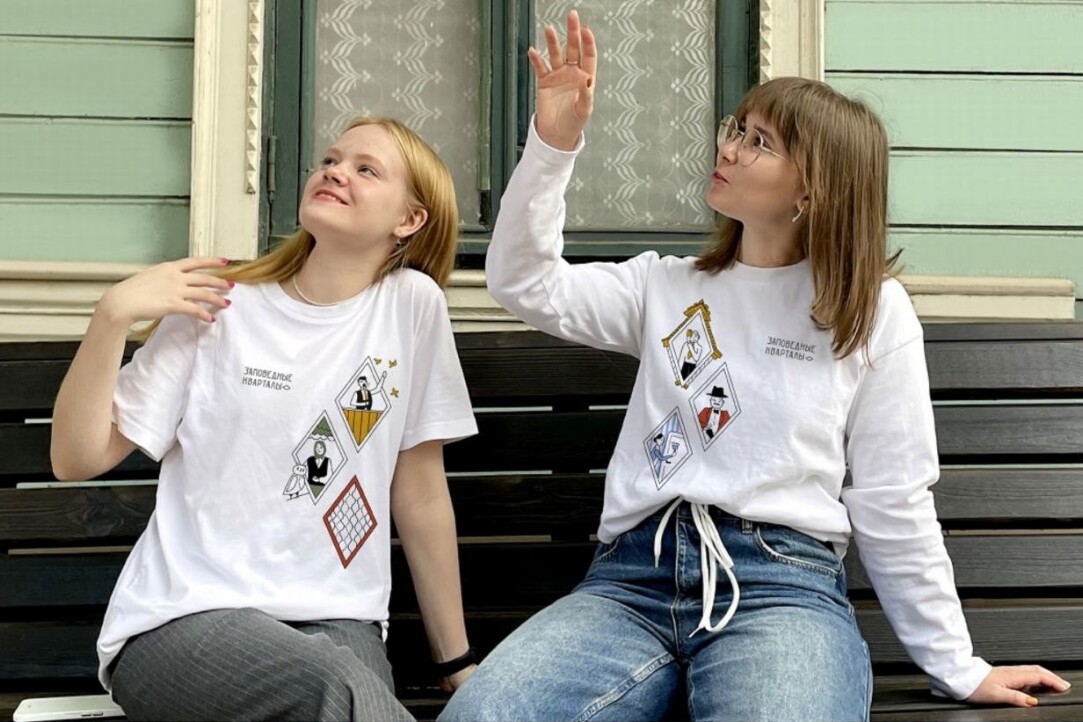‘In Search of the Key to the Past’: Students of HSE Art and Design School in Nizhny Novgorod Develop Collection of Souvenirs

The HSE Art and Design School in Nizhny Novgorod, together with the ‘Protected Quarters’ project to revive Nizhny Novgorod’s historical territories, have carried out the ‘Timeless’ creative project, which included a design laboratory and an educational programme. As a result of the creative workshop, students made concepts for souvenir products based on the local identity.
‘Timeless’ is a joint creative project from the HSE Art and Design School in Nizhny Novgorod and ‘Protected Quarters’. Its goal is to create concepts for unique souvenir products that reveal the symbols and history of Nizhny Novgorod to locals and tourists alike.

To get inspired and start working with meanings, the students took tours of three historical quarters of Nizhny Novgorod, held creative meetings with artists, and went to Gorodets and the Voskresensky district to study wooden architecture and other symbols of the Nizhny Novgorod region. The students became acquainted with the language of visual signs, symbols, artifacts, and images extracted from past eras, then deciphered and transferred them to modern clothing formats.
The educational programme contained a series of lectures and discussions with leading experts in the regional design industry, curators of HSE Art and Design School in Nizhny Novgorod, and artists.
Each group of participants spent a month working in their own way with the symbols, stories, characters, and images of the Three Saints Church quarter. The creative workshop resulted in three design projects that will form the basis for souvenirs and merch for the ‘Protected Quarters’ project.
Design projects prepared by HSE University students and pre-approved by the jury were submitted to public voting. The winning creative project was ‘Through the Portal of History’, made by Team No. 2 consisting of Yana Maksimova, Polina Avdeeva, and Kamila Garayeva.
The concept of the project was based on the stories, characters, images, and details of the Three Saints Church historical quarter. ‘“Protected Quarters” are not only empty wooden houses, but also people and their stories. We wanted to rejuvenate this place. Mirrors, windows, and house doors are symbols of a portal to another world. The past speaks to the present and vice versa,’ commented the team members.
The creative concept of ‘Through the Portal of History’ will serve as a basis to develop year-round and New Year’s souvenir products expressing a love for one’s hometown and its cultural identity.

Yana Maksimova
The initial ideas appeared during trips, then there were many discussions within the team. We came up with project ideas together, and then each of us developed one concept. In fact, they were all great and it was hard to choose just one. When we were elaborating the final concept, I did the graphics while the others made mock-ups and a presentation for the performance. We also took photos together in neighbourhoods for mock-ups.
There were a lot of ideas, and in the end, we decided to create souvenirs featuring local street art. There is a lot of it in the Protected Quarters, and it is also part of the history of the place. We also had the idea to work with interesting house shapes and architecture that is unusual and noteworthy.

Kamila Garayeva
We visited different territories, houses, and churches, which helped us later at the idea stage. It was fascinating to learn stories from people’s lives, details of household activities, and hobbies. Based on these stories, one of our concepts was put forward and later fully developed.
We had completely diverse ideas: from silhouettes of houses to a ‘game’ to find a key to the past. We decided to combine all our strengths and skills to finalise the chosen general design solution. We also worked together to create small, humorous phrases that both remind us of the historical past and connect us with the present.

Polina Avdeeva
Working with ‘Protected Quarters’ was unusual. We were completely immersed in the life of the neighbourhoods, learned the history of each house, and studied them from the inside. In addition to taking tours of the city, we went to the Nizhny Novgorod region for inspiration and to immerse ourselves in the concept. I certainly saw some unique places while working on the project. We visited ancient estates, monasteries, and even rang bells. A sea of excursions, a sea of new impressions and emotions!
In our future work with ‘Protected Quarters’, we will present two collections of souvenirs: off-season and New Year’s. These will be posters, wooden badges, postcards, etc. We will perfect our concept so that very soon, locals and tourists in Nizhny Novgorod will be able to buy souvenirs with our design!
See also:
Flying Robot and Medical Equipment: Projects by HSE University Graduates at ‘Moscow 2030’ Forum
At the end of August, 2025, a large-scale forum ‘Territory of the Future. Moscow 2030’ took place at the Museon Art Park, where students from different universities demonstrated their inventions and art installations. Graduates of the 2025 Master’s programme in Product and Industrial Design at HSE Art and Design School presented the first Russian autonomous flying robot, Belka, and medical equipment designed for disinfecting donated blood, Ance. They shared details of their projects with the HSE News Service.
'The Past Always Remains a Part of the Present'
Sergey Medakin began his career as an art historian by studying Sabaton, a Swedish power metal band, and is now focusing on German studies. In this interview with the HSE Young Scientists project, he discusses his favourite Soviet and Western political cartoons, the scientific conference he founded, and the relevance of the past in modern culture.
ADCR Awards: HSE University Wins in Ten Nominations
In early October, the award ceremony for the winners of ADCR Awards, a Russian professional competition in creativity, design and advertising, took place. This year, all the prizes in the Graphic Design/Product Design category were taken by HSE students. Additionally, the HSE Art and Design School has once again been named the School of the Year, and Leonid Slavin has been recognised as the tutor of the year. In 2024, participants submitted a record 649 works to the competition, of which 84 received awards in various categories.
GRADUATION'24: HSE Art and Design School at the Zaryadye Exhibition
On October 11, 2024, the third exhibition GRADUATION'24 opened at the Parking Gallery of Zaryadye Park. More than 200 promising artists from 22 Moscow institutions are participating in the event. The exhibition features various works from modern painting to computer games created by graduates of different tracks of HSE Art and Design School.
‘Intriguing Collaboration’: HSE Student Works Displayed at Yandex Museum
Last year, HSE University and the team at Yandex Museum launched their first joint competition, ‘New Life of Familiar Things,’ involving students from various fields at the HSE Art and Design School. The winners' works are now displayed at the Yandex Museum. The HSE News Service interviewed the winners about their innovative design and implementation.
‘We Cannot Understand the Modern Ideological Confrontation without the Accusations that Emerged during the Lausanne Process’
Rainer Matos Franco, from Mexico, defended his PhD thesis with honours at HSE University this June. In his dissertation, Rainer Matos Franco examines the history of anticommunism in Europe during the 1920s. The HSE News Service spoke with Rainer and his academic supervisor, Tatiana Borisova, about the significance of the Lausanne Process for the Cold War and contemporary history, the opportunities provided by HSE University for international PhD candidates, and the challenges of working with a vast database of historical sources.
‘New Life of Familiar Things’: Exhibition of Student Projects at Yandex Museum
On July 3, 2024, the Yandex Museum on Paveletskaya in collaboration with the HSE Art and Design School opened an exhibition showcasing familiar objects that have been given new forms, functions, and meanings. The exhibition features the projects of finalists from a competition organised by the HSE Art and Design School and the Yandex Museum. Visitors can explore works created by young designers and talented students of the HSE Art and Design School, who have reimagined familiar objects in the context ofmodern life.
Season Eight of HSE CREATIVE OPEN Competition Begins
HSE CREATIVE OPEN international online competition of the HSE Art and Design School opens the summer season featuring new categories: ‘Visual Research,’ ‘Game Design,’ ‘Motion Design,’ ‘Poster,’ and ‘Digital Product.’
HSE ART GALLERY 2.0: Relaunch and New Space at the Winzavod
HSE ART GALLERY, which was established in 2018, is launching a new exhibition area. This second gallery will be in Winzavod, one of the largest private centres for contemporary art in Russia. The art space on Paveletskaya will become a place for implementing commercial projects and housing exhibitions by HSE Art and Design students and graduates.
HSE University and Pobeda Airlines Launch Joint Competition
HSE Art and Design School, in collaboration with the Pobeda Airlines, has announced the start of a competition to create a new uniform design for flight attendants and representatives of the airline. Young professional designers, as well as students over 18 years old studying at Russian universities in full-time and part-time programmes in the field of ‘Design and Fashion,’ will have the opportunity to showcase their talent.


